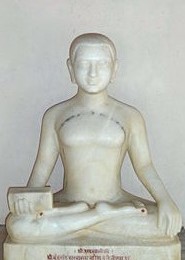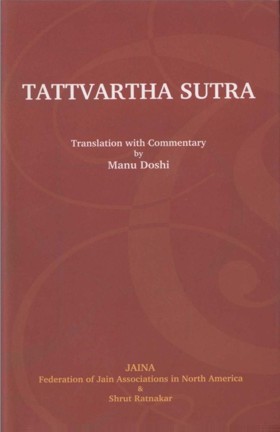10.07 Kshetrakālgatilingtirthachāritrapratyekbuddhabodhitjnānāvagāhanāntarsankhyā'lpabahutvatah Sādhyāh
Audio: Sanskrit: क्षेत्रकालगतिलिंगतीर्थचारित्रप्रत्येकबुद्धबोधितज्ञानावगाहनान्तरसंख्याल्पबहुत्वतःसाध्याः।
Hindi: क्षेत्र,काल,गति,लिंग,तीर्थ,चरित्र,प्रत्येक बुद्धबोधित, ज्ञान, अवगाहना, अंतर, संख्या, अल्पबहुत - इन 12 बातों द्वारा सिद्धों की विशेषताओं का विचार किया जाता है।
English: The liberated souls can be classified in terms of place, time, gender, Tirtha, conduct, Pratyekbuddhabodhit, knowledge, height, interval, numbers, concept of relatively more or less.
In the liberated state all the souls are equal without any differentiating quality. They can, however, be classified differently in light of their previous lives. This sutra mentions the following twelve criteria by which the liberated souls can be classified.
Place:
There are 15 Karmabhoomies (lands, where impact of Karma prevails). Souls can attain liberation from any of them. As such, the liberated ones can be classified as coming from one Karmabhoomi or another.
Time:
Different souls attain liberation at different times. For instance, Lord Rshabhdev attained it in the beginning of the fourth era. while Lord Mahavir attained it by the end of that era. As such, it can be said that a certain number of souls attained liberation in one or another era.
Gati:
Heavenly, human, animal and infernal are the four states of the worldly existence. Exercising of the insight required for liberation is, however, practicable only for human beings. As such, attainment of liberation is possible only in the human life. But if we take into consideration the previous lives of liberated souls, it can be said that particular number of souls attained liberation from one or another type of existence.
Ling:
This can be interpreted as gender as well as external symbol. From the former point of view it can be said that so many males or so many females attained liberation in a particular period. This interpretation is acceptable only to Shwetāmbars. From the latter point of view, various people might have adopted different symbols prior to gaining liberation. They can therefore be classified in terms of those symbols. The external symbol is, however, of no significance for attaining liberation; one can attain it irrespective of the symbol.
Tirtha:
Some souls attain liberation as Tirthankars, who set up the religious order. Others attain it without being Tirthankars. The liberated souls can therefore be classified as Tirthankars and non-Tirthankars.
Chāritra:
Sāmāyik, Chhedopasthāpan, Parihār-vishuddhi, Sookshmasamparāy and Yathākhyāt are the five types of Charitra as mentioned in chapter 9. The last is most important, because it is not possible to attain liberation without resorting to Yathākhyāt Chārita. But the earlier ones also are significant. As such, the liberated ones can be classified as having observed one type of Chāritra or another.
Pratyekbuddhabodhit:
The term covers Pratyekbodhit and Buddhabodhit. The former denotes those, who attain liberation without help from others, as is the case with Tirthankars and Swayambuddhas. The latter denotes those, who need help from others. The liberated souls can therefore be classified as Pratyekbodhit or Buddhabodhit
Jnān:
Knowledge is of five types. Of course, no one can gain liberation without omniscience. Since other types of knowledge like sensory are instrumental in gaining omniscience, it can be said that different souls, having different types of knowledge, have attained liberation. The liberated souls can therefore be classified as having attained it by two or three or four types of knowledge.
Avagāhanā (height):
Heights of the people vary from time to time. Jainism conceives of inordinate height of human beings and states that the heights of those, who attain liberation, vary from 7 feet at the minimum to the maximum of 500 bow-length. The liberated souls can therefore be classified in terms of their heights in the last life. In the liberated state they are supposed to retain two/third of the size of their last life. As such, they can also classified in terms of their size in the liberated state.
Antar (interval):
The order of liberation can be incessant or intermittent. When one being is liberated immediately after another, it is termed as incessant. Jainism measures time in terms of Samay, which is an infinitesimal part of a second. The incessant order of liberation can continue minimum for two Samays and the maximum for eight Samays. When there is an interval between the two consecutive cases of liberation, the order is said to be intermittent. The minimum time of such interval is one Samay and the maximum is of six months.
Number:
It is laid that at least one and the maximum 108 souls can be liberated in one Samay. It can also be said that innumerable souls have attained liberation in the past and innumerable more will attain it in future.
Alpabahutva:
This means more or less. It denotes drawing an analytical view based on the above-mentioned eleven criteria. For instance, there are many more beings in the infernal abodes than in the heavenly abodes. It can therefore be surmised that more souls are liberated out of those inhabiting the infernal abodes than those in the heavenly ones. To take time as a unit, it can be said that more souls are liberated in the earlier eras than in the latter ones. That type of analysis can also be drawn in terms of mode and the liberated souls can be classified accordingly.
 Acharya Umaswati
Acharya Umaswati
